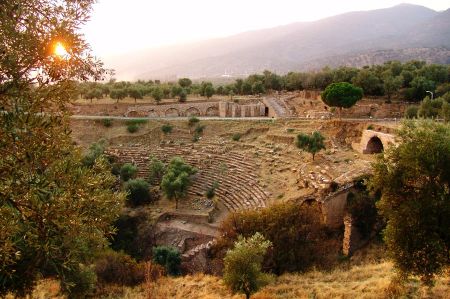Nysa of Caria
- The Ancient City of Romantic Breeze
The ancient city of Nysa was a famous settlement in Western Anatolia in Roman-Byzantine times. The well known traveller Strabon of Amaseia described Nysa as a kind of double city as it was situated on either sides of a tributary stream.
The buildings and open areas are supported by vaulted substructures. The cities most brilliant days were in the Roman Empire period but it still continued in Byzantine and Ottoman period.
Nysa, one of the most important cities of Caria in Hellenistic and Roman period, is located on the northwest of Sultanhisar in western Anatolia of Turkey.
The following buildings can still be seen and offering an idea of the former importance of the city: The Gymnasium, the stadium, the theatre, the library, the tunnel, three bridges, the Bouleuterion, the Agora and the Roman-Byzantíne bath. The sacred space of this ancient city is in Salavatli, 7 kilometres west to Sultanhisar, called Acharaca, with the temples of Pluto and Demeter.
The Theatre
1st century B.C. until 2nd and 3rd century A.C.
The Cavea is slightly more than semi-circular. It offers capacity for more than 12000 persons. It faces to the south and has two diazomas (passages). It´s lower part is divided into nine segments, it´s upper part into 16 segments. The stage building displays a relief frieze depicting the life of Dionysos, the wine god in Nysa.
The Bouleuterion (Local Counsil)
1st century B.C. - 2nd century A.C.
The Bouleuterion, which Strabon called Gerontikon (House of the Council of the eldest), is the best preserved building of the ancient city. It is a rectangular house with it´s council hall in a semicircular shape (Cavea). Five flights of steps divide this Cavea into four segments of 12 rows of seats each. It offers room for 600 to 700 people.
Roman Bridge
The Nysa Bridge is a late imperial Roman bridge over the stream in Nysa (modern Sultanhisar), in the ancient region of Caria, Turkey. The 100 m (328 ft) long substructure was the second largest of its kind, after the Pergamon Bridge.
The bridge served as a substructure for the area in front of the city theatre which lay close to the stream. It spanned the Tekkecik stream on a length of some 100 m (328 ft), giving the structure of a tube or a tunnel, although it was constructed entirely above ground. It consists of a single, 5.7 m (19 ft) wide vault with its uphill mouth widening to 7 m (23 ft).
